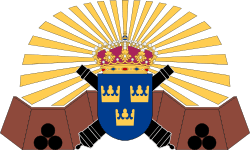Vaxholm Coastal Artillery Regiment
Coordinates: 59°23′35″N 18°25′53″E / 59.39306°N 18.43139°E
| Vaxholm Coastal Artillery Regiment | |
|---|---|
| Vaxholms kustartilleriregemente (KA 1) | |
 | |
| Active | 1902–2000 |
| Country | Sweden |
| Allegiance | Swedish Armed Forces |
| Branch | Swedish Navy |
| Type | Coastal artillery |
| Size | Regiment |
| Part of |
Milo Ö (1942–1991) Milo M (1991–2000) |
| Garrison/HQ | Rindö |
| March |
"Honnör för Finska Gardet" by R. Arnoldsson (1902–1948) "Gardeskamrater" by S. Rydberg (1948–2000) |
| Commanders | |
| Notable commanders | Håkan Syrén |
| Insignia | |
| Insignia |
 |
| Flag |
 |
Vaxholm Coastal Artillery Regiment (Swedish: Vaxholms kustartilleriregemente), designation KA 1, was a Swedish Navy coastal artillery regiment of the Swedish Armed Forces which operated between 1902 and 2000. The unit was based at Rindö in the Stockholm archipelago in Uppland.
History
On 1 January 1902, the Swedish coastal artillery was established as a separate military branch in the Swedish Armed Forces, following a decision taken in May the previous year. The decision meant that Karlskrona Artillery Corps and Vaxholm Artillery Corps was disbanded and that a coastal artillery was established.[1] The Vaxholm Artillery Corps was transferred to the coastal artillery and formed the Vaxholm Coastal Artillery Regiment (KA 1). The regiment manned the Vaxholm Fortress and Oskar-Fredriksborg Fortress as well as Fårösund's coastal position and Hörningsholm's coastal position.[2]
The regimental buildings, drawn by Erik Josephson, were completed in 1906. The barracks were completed already in 1904 and had three floors unlike the design which had four.[3] Parts of KA 1 was placed at Vaxholm and it was not until the 1940s that the operations were collocated to eastern Rindö next to Oskar-Fredriksborg Fortress. KA 1 consisted of artillery companies, naval mine companies and yrkes (occupational) companies: an organization that was maintained until the 1940s. In 1941, the former buildings of the Vaxholm Grenadier Regiment (I 26) became a part of the KA 1. The part of the KA 1 that has been placed at the Vaxholm Fortress was instead placed in the former barracks of I 26.[3]
In 1981 the regiment became subordinated to the Stockholm Coastal Artillery Defense (Stockholms kustartilleriförsvar, SK/Fo 46) and renamed Stockholm Coastal Artillery Defense with Vaxholm Coastal Artillery Regiment (Stockholms kustartilleriförsvar med Vaxholms kustartilleriregemente, SK/KA 1). This organization was retained until SK was merge with the East Coast Naval Command (Ostkustens marinkommando) in 1990.[4] The regiment was renamed the Vaxholm Amphibious Regiment (Vaxholm amfibieregemente, Amf 1) in 2000, when parts of the coastal artillery was converted into the Swedish Amphibious Corps. Vaxholm Coastal Artillery Regiment was disbanded on 31 October 2000.[1]
Organization
In 1956 the organization was as follows:[5]
- Blocking battalion with battalion staff
- Battalion (staff and military communications training)
- Battalion (heavy naval artillery)
- Battalion (light naval artillery)
- Naval mine battalion and battalion staff
- Naval Mine School
- Minelayer division (mine and dive training)
- Minelayer division (boat training)
- Close Combat School (Närförsvarsskolan) with school staff
- Coastal Ranger Company
- Coastal Ranger Company
Commanding officers
- 1902-1904 - Colonel Oskar Sylvander
- 1904-1914 - Colonel Karl Wirgin
- 1914-1924 - Colonel Herman Gustaf Mauritz Wrangel
- 1924-1926 - Colonel Sam Bolling
- 1926-1929 - Colonel Tor Wahlman
- 1929-1935 - Colonel Theodor Hasselgren
- 1935-1936 - Colonel Harald Engblom
- 1936-1940 - Colonel Frej Kuno Allbrandt
- 1940-1947 - Colonel Allan Cyrus
- 1947-1951 - Colonel Emil Cederlöf
- 1951-1957 - Colonel Bo Lindeberg
- 1957-1962 - Colonel Olof Karlberg
- 1962-1967 - Colonel Curt Karlberg
- 1967-1969 - Colonel Björn Engwall
- 1969-1974 - Colonel Eric Jarneberg
- 1974-1977 - Colonel Sven-Åke Adler
- 1977-1981 - Colonel Per-Gunnar Fernander
- 1981-1983 - Colonel Lars-Göran Persson
- 1983-1987 - Colonel Per Lundbeck
- 1987-1990 - Colonel Fredrik Hillelson
- 1990-1992 - Colonel Bertil Kristensson
- 1992-1994 - Colonel Claes-Göran Hedén
- 1994-1996 - Colonel Håkan Syrén
- 1996-2000 - Colonel Stefan Jontell
References
- 1 2 Lindén, Mattias (2013). "Uppförandet av Kustartilleriet som vapengren 1902" [The establishment of the coastal artillery as a military branch in 1902] (PDF) (in Swedish). Linnaeus University. pp. 1, 34. Retrieved 18 October 2016.
- ↑ Westrin, Theodor, ed. (1915). Nordisk familjebok: konversationslexikon och realencyklopedi (in Swedish) (Ny, rev. och rikt ill. uppl. ed.). Stockholm: Nordisk familjeboks förl. p. 336. LIBRIS 8072220.
- 1 2 "Kulturmiljöinventering av f.d. Kustartilleriregemente KA 1 vid Oscar Fredriksborg på Rindö, Vaxholm" (in Swedish). Vasallen, Nyréns Arkitektkontor. 12 January 2007. pp. 9–10. Archived from the original (PDF) on 2 January 2013. Retrieved 18 October 2016.
- ↑ Birke, Sune; Braunstein, Christian (2011). Sveriges marina förband och skolor under 1900-talet. Skrift / Statens försvarshistoriska museer, 1101-7023 ; 13 (in Swedish). Stockholm: Statens försvarshistoriska museer. p. 47. LIBRIS 12638815.
- ↑ Eriksson, Tim (16 February 2008). "Waxholms Kustartilleriregemente KA1". www.kustartilleriet.gearhead.se (in Swedish). Kustartilleriet.se. Retrieved 20 March 2010.
Further reading
| Wikimedia Commons has media related to Vaxholms kustartilleriregemente. |
- Ljungberg, Mauritz C:son (1982). "Kungl. Vaxholms kustartilleriregemente: några anteckningar om dess föregångare". Vaxholms fästnings museum (in Swedish). 1982 (22): 5–44 : ill. ISSN 0349-4802. LIBRIS 10256133.